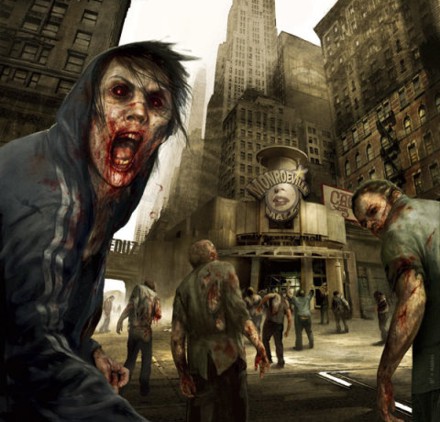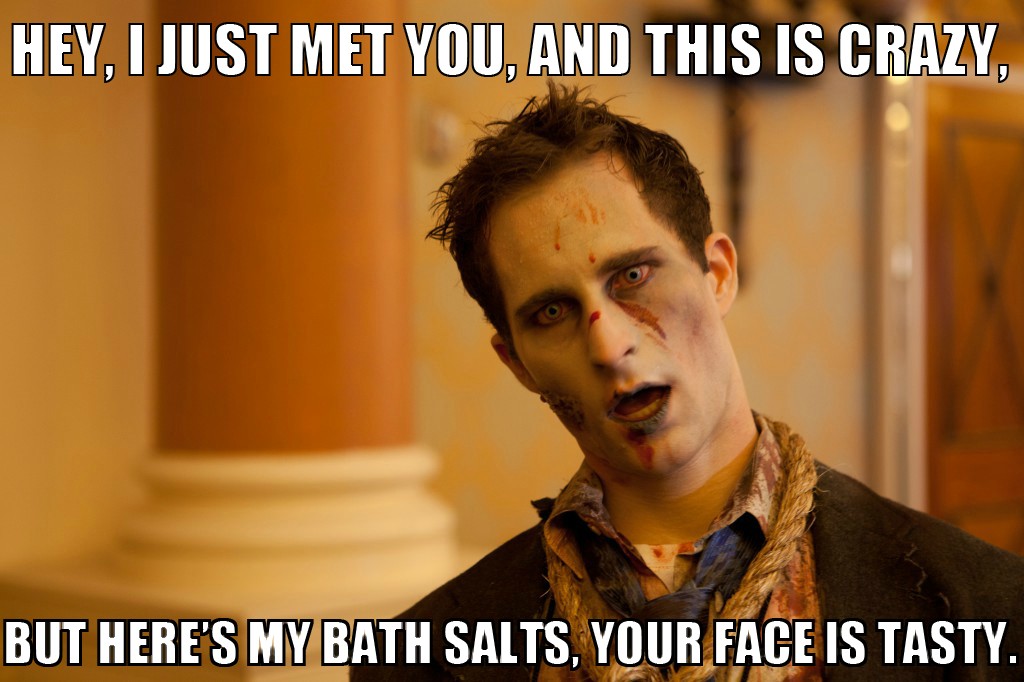Tag Archives: zombie
ZOMBIES IN THE BIBLE – THE DEAD COMETH

Zechariah 14:12
And the LORD will send a plague on all the nations that fought against Jerusalem. Their people will become like walking corpses, their flesh rotting away. Their eyes will rot in their sockets, and their tongues will rot in their mouths.
Zechariah 14:13
On that day they will be terrified, stricken by the LORD with great panic. They will fight their neighbors hand to hand.
There are several other biblical passages that allude to a plague that will decimate mankind in the end times.
Many people take the bible as the truth, and also see it as a book of prophecy. Could we have received warning of the impending rising of the undead from antiquity? We don’t have to go far to rationalize this. Prophets in ancient times may have seen exactly what happened, but didn’t understand the science behind it to describe it accurately. They may have seen the biological cause engineered in a lab and unleashed upon the world, but could only use simple words to describe it.
There are currently so many end times prophecies that it can make your head spin. Almost all of them don’t point to an exact cause of the apocalypse, but the bible seems to point to the undead several times
Revelation 11:6
These men have power to shut up the sky so that it will not rain during the time they are prophesying; and they have power to turn the waters into blood and to strike the earth with every kind of plague as often as they want.
Revelation 11:8
Their bodies will lie in the street of the great city, which is figuratively called Sodom and Egypt, where also their Lord was crucified.
Revelation 11:11
But after the three and a half days a breath of life from God entered them, and they stood on their feet, and terror struck those who saw them.
Ezekiel 37:10
So I prophesied as he commanded me, and breath entered them; they came to life and stood up on their feet–a vast army.
The bible is rife with resurrection, the dead coming to life, and stories and illiterations to the end of times. Perhaps, the plague God uses to wipe the earth clean is a plague of Zombies. You can also point to end times prophecy references of Locusts and say that zombies could also be considered as a locust, devouring all life. At this point, all we can do is speculate and prepare. We don’t know how or when the world will end, but we can be ready if it is survivable.
***Notes***
The end of the world can be described several ways:
1. A literal end, where the entire world is destroyed.
2. An end to the way the whole world sees itself.
3. A massive culling of the world’s population so that it is more in balance.
4. A massive culling of the world’s population so that it can be enslaved by those in power.
How a Zombie Outbreak Could Happen in Real Life
Could zombies actually exist? What would it take for human corpses to rise up and hunt the living? We often think zombies are scientifically impossible — but actually, they’re just very implausible. Here’s one wayThe Walking Dead could happen in real life.
To start our zombie thought experiment, we need to make some basic assumptions. First, we’re ignoring all supernatural zombie origins. We’re also going to set aside space radiation, mysterious comets, or Russian satellites. Our focus will be narrowed to biological origins –- a zombie contagion. Of course, there are many different zombie scenarios in books and film, and no one theory is going to cover all of them perfectly.
The first aspect of human zombification we need to tackle is basic zombie physiology. In virtually every zombie scenario, zombies are able to function despite increasing levels of physical deterioration due to injury or decomposition. There has to be some mechanism for transmitting neural impulses from the brain to various body parts, and for providing energy to muscles so they can keep operating.
The most common science fictional explanation for zombie outbreaks is a virus — but viruses and bacterial infections are not known for building large new physical structures within the body. So let’s count viruses out. Instead, the need for a mechanism to activate deteriorating body parts actually provides the cornerstone of what is, in my opinion, the strongest theory: fungal infection.

We know that fungi can infect humans. We also know that fungal networks exist in most of the world’s forests. These mycorrhizal networks have a symbiotic relationship with trees and other plants in the forest, exchanging nutrients for mutual benefit. These networks can be quite large, and there are studies that demonstrate the potential for chemical signals to be transmitted from one plant to another via the mycorrhizal network. That, in turn, means that fungal filaments could perform both vascular and neural functions within a corpse.
This leads us to the following scenario: microscopic spores are inhaled, ingested, or transmitted via zombie bite. The spores are eventually dispersed throughout the body via the bloodstream. Then they lie dormant. When the host dies, chemical signals (or, more accurately, the absence of chemical signals) within the body that occur upon death trigger the spores to activate, and begin growing. The ensuing fungal network carries nutrients to muscles in the absence of respiration or normal metabolism.
Part of the fungal network grows within the brain, where it interfaces with the medulla and cerebellum, as well as parts of the brain involving vision, hearing and possibly scent. Chemicals released by the fungi activate basic responses within these brain areas. The fungi/brain interface is able to convert the electrochemical signals of neurons into chemical signals that can be transmitted along the fungal network that extends through much of the body. This signal method is slow and imperfect, which results in the uncoordinated movements of zombies. And this reliance on the host’s brain accounts for the “headshot” phenomenon, in which grievous wounds to the brain or spine seem to render zombies fully inert.
This leaves the problem of zombie metabolism. Where do the zombies get the nutrients needed to perform physical activity, plus the necessary nutrients to fuel the life-cycle of the fungi? This is most easily explained by the zombies’ constant, endless drive to devour meat. The fungal network would still need some way to metabolize meat, and zombies seem to be able to function even in the absence of a human digestive system.
It is possible that this particular fungi has evolved a means to extract energy and nutrients from meat in a similar manner to carnivorous plants. The ingestion of meat may actually be vestigial, an unintended result of the drive to bite. In this case, the fungi may draw energy from the decomposition of the host’s own organic material, which effectively puts a shelf-life on zombies (in addition to the deterioration of body structures beyond the point where the fungal network can compensate).
Accounts of dismembered parts moving purposefully may be apocryphal.
Now we have established a working theory for fungal zombies. How could such a disease arise? The goal of any biological organism is to live long enough to reproduce, but many pathogens are self-limited by their own lethality. The host dies before it has a chance to spread the pathogen inadvertently. This gives us two pathways for development of the zombie fungus. First, a fungal species existed that used the digestive tracts of mammals to travel. In other words, animals ingested the fungus, including spores. The spores were later defecated out in a new location. Some mutations occurred that caused the spores to gestate while still within the host. However, in most cases, the host’s immune system would destroy the fungus. Further mutations could lead to spores that only trigger once the host has died, avoiding this problem.
Another possibility is a fungal infection that was highly aggressive and caused rapid death within the host. That strain was not able to successfully reproduce as often as a mutated strain that delayed activation until post-mortem.
Of course, it’s one thing for a fungus to activate after the host dies, and quite another for the dead host to stand up and start attacking things. There are many evolutionary steps in between, which is why a zoonotic origin seems likely.
The precursor fungus could have been ingested by pigs, which are omnivorous. Captive pig populations, subject to overcrowding, would have been perfect places for the fungus to spread and mutate. In some poorly managed pig farms, dead pigs may have gone unnoticed, allowing post-mortem development of the fungus. Dead pigs were likely partially eaten by their living counterparts, allowing the fungal strains with post-mortem mutations to spread back into the population. The method of transfer from the pig population to the human population seems fairly obvious.
The evolution of fully mobile dead pigs probably started with a simple bite reflex that could transmit spores to nearby pigs. A bite combined with a muscular spasm, a sort of lunge, would work even better. After many generations, this developed into full post-mortem mobility. Thus, a dead host went from a drawback to an advantage, becoming a mobile platform for spore distribution. In fact, the zombie hunger drive may have originated as a spore distribution method –- only later was the ability to metabolize meat acquired. We can extrapolate this development to assume the further refinement of the fungal neural system, allowing for zombies which are far more coordinated and can run at nearly full speed.
While this type of behavior modification may seem unlikely, there is precedent for it within the animal world. Several species of parasitic wasps are able to reprogram the behavioral patterns of their hosts (bees, ants and even caterpillars), creating complex new behaviors beneficial to the wasp and detrimental to the host. While the hosts in these cases aren’t dead, this does demonstrate that complex chemical overrides can evolve in nature.
Hopefully scientists can develop an effective zombie fungicide in time.
Colbert: Zombies Are Intellectual Elites – ‘All They Care About Is Braiiiiiiins’
 College student eating a housemate’s heart? Homeless man eating another homeless man’s face? Porn star sending body parts to government members? “Cannibalism is the hot new trend,” observed Stephen Colbert on last night’s Colbert Report. “And you thought saggy pants were annoying.” The recent spate of these freak incidents in the news has wide swathes of the American public convinced we have a zombie apocalypse on our hands. “It does make one wonder,” Colbert said. “After all, something has clearly eaten [Fox News host] Trace Gallagher’s brain.”
College student eating a housemate’s heart? Homeless man eating another homeless man’s face? Porn star sending body parts to government members? “Cannibalism is the hot new trend,” observed Stephen Colbert on last night’s Colbert Report. “And you thought saggy pants were annoying.” The recent spate of these freak incidents in the news has wide swathes of the American public convinced we have a zombie apocalypse on our hands. “It does make one wonder,” Colbert said. “After all, something has clearly eaten [Fox News host] Trace Gallagher’s brain.”
So it came as a relief when the federal Centers for Disease control on June 1 told the Huffington Post that “CDC does not know of a virus or condition that would reanimate the dead (or one that would present zombie-like symptoms).” Colbert was not buying it, though, especially in light of a (tongue-in-cheek”) CDC “zombie awareness” campaign last year. “It makes sense that zombies would be attracted to science,” he said. “I mean, they’re intellectual elites. All they care about is braaaaaiiiiiinnnnns.”
Miami ‘zombie-like’ attacks continue? Man on ‘Cloud 9′ growls, tries to bite North Miami Beach cop
 NORTH MIAMI BEACH, Fla. (WSVN) — Officers say a man in police custody has an entire department shocked after he allegedly growled and tried to bite an officer’s hand off; an eerie resemblance to the cannibal attack on a South Florida causeway.
NORTH MIAMI BEACH, Fla. (WSVN) — Officers say a man in police custody has an entire department shocked after he allegedly growled and tried to bite an officer’s hand off; an eerie resemblance to the cannibal attack on a South Florida causeway.
Two North Miami Beach officers were eating at a Boston Market in North Miami Beach on Saturday evening, when Brandon DeLeon, a homeless man, walked into the restaurant and began to yell obscenities at them.
DeLeon then threatened to fight the police officers, forcing them to place him under arrest. But it was the events after DeLeon was put into a holding cell that has officers very concerned.
According to an officer’s safety bulletin, “While at the holding cell, DeLeon banged his head repeatedly inside the holding cell. DeLeon growled at officers in the booking area like a rabid dog. DeLeon attempted to bite Officer Ruiz’s hand off.”
The incident sounds eerily similar to the case of Rudy Eugene who, when confronted by Miami Police under the MacArthur Causeway while ripping the flesh off of homeless man Ronald Poppo, allegedly started to growl.
It has been speculated that Eugene, who chewed off 75 percent of Poppo’s face, had been on drugs at the time of the incident before being shot and killed by police.
Authorities believe DeLeon was on drugs when he tried to bite the officer’s hand off and have advised officers to be extra careful when it comes to the homeless community in South Florida. The officer’s safety bulletin goes on to read: “It was later discovered DeLeon had taken a synthetic drug named Cloud 9. This bears resemblance to the incident that occurred in the City of Miami last week when a male ate another man’s face. Please be careful when dealing with our homeless population during your patrols.”
Cloud 9 is a synthetic drug with terrible side effects such as rage, hallucinations and paranoia.
During a bond hearing on Monday, DeLeon told a judge he couldn’t remember the events. “I have no recollection of anything that happened that night,” he said.
According to 7News sources, the day after the incident with DeLeon, officers stopped some people in the homeless community and found the synthetic drug.
The concern among law enforcement is that Cloud 9 is becoming the drug of choice within the homeless community, and the overriding concern is the violent side effects.
North Miami Beach Police also said DeLeon had the caffeinated, alcoholic beverage Four Loko in his system.
DeLeon remains in jail under a $5,500 bond.

